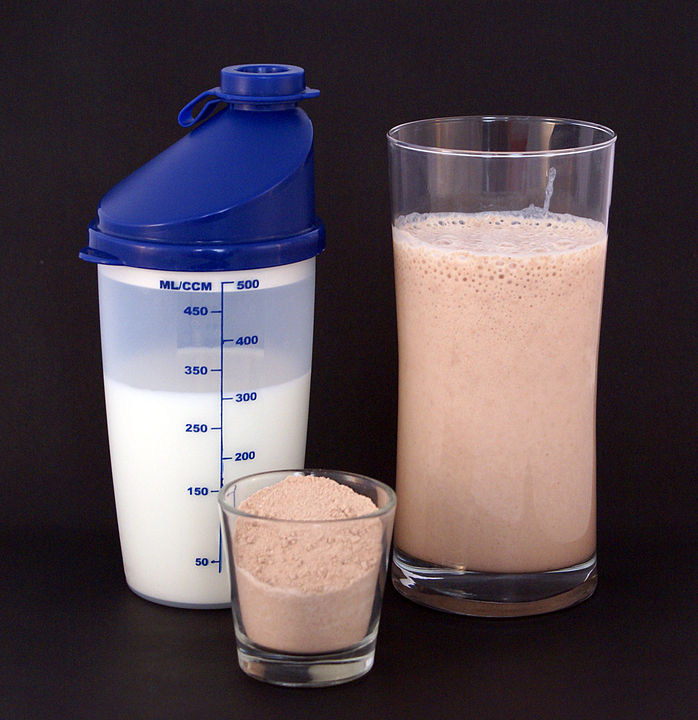7.1 – Introduction to Proteins and Vegetarianism
Big Idea
Protein is best used for vital body functions—eat just enough for your lifestyle needs.
Some dieters use protein bars as a prime part of their diet, with the hopes of slimming their waistlines. Exercise cafes serve protein shakes to many of their customers, who drink them for building muscle and enhancing exercise recovery. Some people have stopped eating meat and feel the need to use protein supplements to ensure they are getting their required protein intake each day. After all, protein is a vital constituent of all organs in the body and is required to synthesize hormones, enzymes, and a variety of molecules.

By Sandstein – Own work, CC BY 3.0
It is no wonder that so many people are preoccupied with optimizing their dietary protein intake. Dieters, athletes, physically active people, and vegetarians may worry that they lack protein in their diet and that they need to consume more from protein bars, shakes, or supplements to perform better and optimize health. This chapter will help address these concerns. First, let us take a look at vegetarian diets.
By definition, a vegetarian who does not eat any type of animal product is called a Vegan. There are different types of semi-vegetarians. Four common forms of semi-vegetarianism are:
- Lacto-Ovo vegetarian. This is the most common form. This type of semi-vegetarian eats eggs and dairy.
- Lacto-vegetarian. This type of semi-vegetarian eats dairy products but not eggs.
- Ovo-vegetarian. This type of semi-vegetarian eats eggs but not dairy products.
- Pescatarian-This type of semi-vegetarian eats fish, but no meat or eggs.
People choose a vegetarian diet for various reasons, including religious doctrines, health concerns, ecological and animal welfare concerns, or simply because they dislike the taste of meat. Vegetarianism has been practiced for centuries. In the fourth century BC, great thinkers such as Pythagoras and Plato promoted vegetarian diets in their natural philosophies. Ancient Olympians were placed on vegetarian diets one month prior to the Olympic Games.
Gladiators were tough men who fought violently against each other during games sponsored by the Roman Empire’s upper-class political rulers. In 1993, archaeologists uncovered a gladiator burial ground not far from the Temple of Artemis. To their surprise, forensic analysis of the gladiators’ bones revealed that they consumed a vegetarian diet. This information matches other historical accounts that gladiators ate a diet rich in barley and dried fruits. Uncooked hulled barley is a very nutritious whole grain; it is an excellent protein source, containing more than 20 grams of protein and all nine essential amino acids in a one-cup serving.
Although the great philosophers, ancient Olympic athletes, and Roman gladiators saw vegetarianism as a means of maintaining optimal health, it took a while for the vegetarian dietary pattern to catch on in America. In 1987, John Robbins wrote “Diet for a New America” and popularized the vegan diet first introduced by Jay Dinshah in the United States in 1960. In the early 1990s, Dr. John McDougall wrote a series of books that promoted vegan dietary regimens to ward off chronic disease. Also during the 1990s, scientific evidence accumulated that supported that diets consisting of too much red meat were linked to chronic disease. This prompted many health organizations, such as the Academy of Nutrition and Dietetics(AND) to issue statements endorsing the health benefits of vegetarian diets.
Visit these websites to learn more:
- Vegetarian, Vegan, and Meals without Meat
- The Basics of Vegetarianism
- Getting Started Basics for New Vegetarians
The US federal government was unable to ignore the health benefits of plant-based diets any longer, and consequently released the 2010 Dietary Guidelines in which Americans were challenged to eat a more plant-based diet. Moreover, the Dietary Guidelines advisory committee stated, “In prospective studies of adults, compared to nonvegetarian eating patterns, vegetarian-style eating patterns have been associated with improved health outcomes—lower levels of obesity, reduced risk of cardiovascular disease, and lower total mortality.” Today, the 2020-2025 Dietary Guidelines for Americans include the Healthy Vegetarian Eating Pattern among its healthy eating patterns.
You may not choose a vegetarian plan of eating for all your meals, but choosing at least some meatless meals per week can make a difference in your health and save you money as well.
You Decide
What are the best sources of protein and how much protein do I need to eat to have a healthy diet?
Whether you choose to consume protein from animal- or plant-derived products, an important factor to consider is the entire nutrient package of the food. What other fats, nutrients, additives, or preservatives come with the protein source? Red meat is a popular choice for protein, but it can contain high amounts of saturated fat. Fish is another good protein choice, and it provides much less saturated fat than other meats, in addition to more healthy fats. Some plant-based sources of protein contain high amounts of protein per serving with just under one gram of less desirable fat in addition to good amounts of healthy fats. As you read through this chapter you will learn how to choose the best protein sources to support your health.

